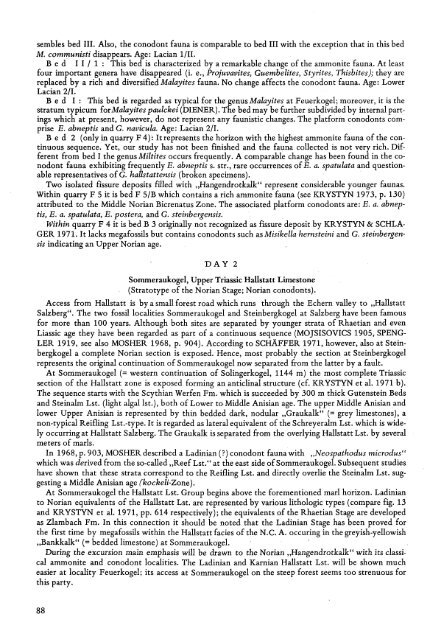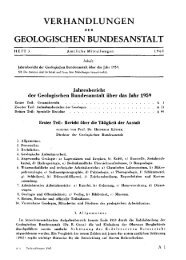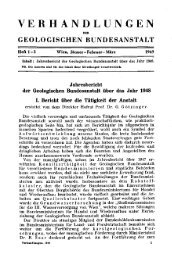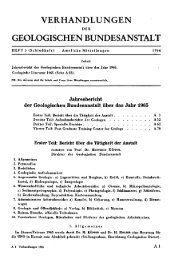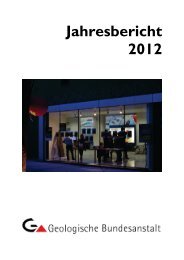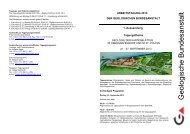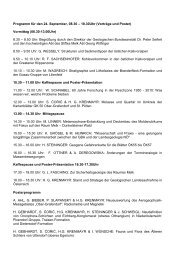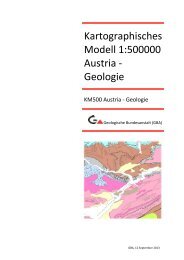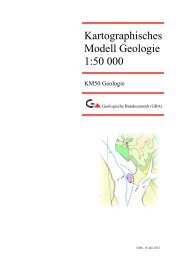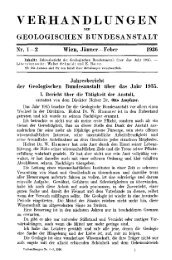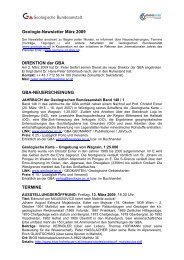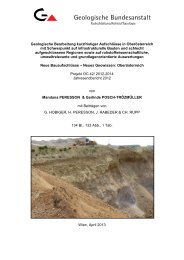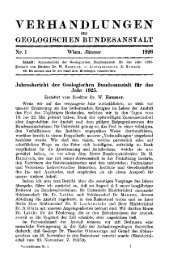Field Trip B TRIASSIC CONODONT LOCALITIES OF THE ...
Field Trip B TRIASSIC CONODONT LOCALITIES OF THE ...
Field Trip B TRIASSIC CONODONT LOCALITIES OF THE ...
You also want an ePaper? Increase the reach of your titles
YUMPU automatically turns print PDFs into web optimized ePapers that Google loves.
sembles bed III. Also, the conodont fauna is comparable to bed III with the exception that in this bed<br />
M. communisti disappears. Age: Lacian l/II.<br />
Bed I I / 1 : This bed is characterized by a remarkable change of the ammonite fauna. At least<br />
four important genera have disappeared (i. e., Projuvavites, Guembelites, Styrites, Thisbites); they are<br />
replaced by a rich and diversified Malayites fauna. No change affects the conodont fauna. Age: Lower<br />
Lacian 2/1.<br />
B e d I : This bed is regarded as typical for the genus Malayites at Feuerkogel; moreover, it is the<br />
stratum typicum for Malayites paulckei (DIENER). The bed may be further subdivided by internal partings<br />
which at present, however, do not represent any faunistic changes. The platform conodonts comprise<br />
E. abneptis and G. navicula. Age: Lacian 2/1.<br />
B e d 2 (only in quarry F 4): It represents the horizon with the highest ammonite fauna of the continuous<br />
sequence. Yet, our study has not been finished and the fauna collected is not very rich. Different<br />
from bed I the genus Miltites occurs frequently. A comparable change has been found in the conodont<br />
fauna exhibiting frequently E. abneptis s. str., rare occurrences of E. a. spatulata and questionable<br />
representatives of G. hallstattensis (broken specimens).<br />
Two isolated fissure deposits filled with ,,Hangendrotkalk" represent considerable younger faunas.<br />
Within quarry F 5 it is bed F 5/B which contains a rich ammonite fauna (see KRYSTYN 1973, p. 130)<br />
attributed to the Middle Norian Bicrenatus Zone. The associated platform conodonts are: E. a. abneptis,<br />
E. a. spatulata, E. postera, and G. steinbergensis.<br />
Within quarry F 4 it is bed B 3 originally not recognized as fissure deposit by KRYSTYN & SCHLA<br />
GER 1971. It lacks megafossils but contains conodonts such asMisikella hernsteini and G. steinbergensis<br />
indicating an Upper Norian age.<br />
DAY 2<br />
Sommeraukogel, Upper Triassic Hallstatt Limestone<br />
(Stratotype of the Norian Stage; Norian conodonts).<br />
Access from Hallstatt is by a small forest road which runs through the Echern valley to „Hallstatt<br />
Salzberg". The two fossil localities Sommeraukogel and Steinbergkogel at Salzberg have been famous<br />
for more than 100 years. Although both sites are separated by younger strata of Rhaetian and even<br />
Liassic age they have been regarded as part of a continuous sequence (MOJSISOVICS 1905, SPENG<br />
LER 1919, see also MOSHER 1968, p. 904). According to SCHÄFFER 1971, however, also at Steinbergkogel<br />
a complete Norian section is exposed. Hence, most probably the section at Steinbergkogel<br />
represents the original continuation of Sommeraukogel now separated from the latter by a fault.<br />
At Sommeraukogel (= western continuation of Solingerkogel, 1144 m) the most complete Triassic<br />
section of the Hallstatt zone is exposed forming an anticlinal structure (cf. KRYSTYN et al. 1971 b).<br />
The sequence starts with the Scythian Werfen Fm. which is succeeded by 300 m thick Gutenstein Beds<br />
and Steinalm Lst. (light algal 1st.), both of Lower to Middle Anisian age. The upper Middle Anisian and<br />
lower Upper Anisian is represented by thin bedded dark, nodular „Graukalk" (= grey limestones), a<br />
non-typical Reifling Lst.-type. It is regarded as lateral equivalent of the Schreyeralm Lst. which is widely<br />
occurring at Hallstatt Salzberg. The Graukalk is separated from the overlying Hallstatt Lst. by several<br />
meters of marls.<br />
In 1968, p. 903, MOSHER described a Ladinian (?) conodont fauna with „Neospathodus microdus"<br />
which was derived from the so-called „Reef Lst." at the east side of Sommeraukogel. Subsequent studies<br />
have shown that these strata correspond to the Reifling Lst. and directly overlie the Steinalm Lst. suggesting<br />
a Middle Anisian age (kockeli-Zone).<br />
At Sommeraukogel the Hallstatt Lst. Group begins above the forementioned marl horizon. Ladinian<br />
to Norian equivalents of the Hallstatt Lst. are represented by various lithologic types (compare fig. 13<br />
and KRYSTYN et al. 1971, pp. 614 respectively); the equivalents of the Rhaetian Stage are developed<br />
as Zlambach Fm. In this connection it should be noted that the Ladinian Stage has been proved for<br />
the first time by megafossils within the Hallstatt facies of the N.C. A. occuring in the greyish-yellowish<br />
„Bankkalk" (= bedded limestone) at Sommeraukogel.<br />
During the excursion main emphasis will be drawn to the Norian „Hangendrotkalk" with its classical<br />
ammonite and conodont localities. The Ladinian and Karnian Hallstatt Lst. will be shown much<br />
easier at locality Feuerkogel; its access at Sommeraukogel on the steep forest seems too strenuous for<br />
this party.<br />
88


